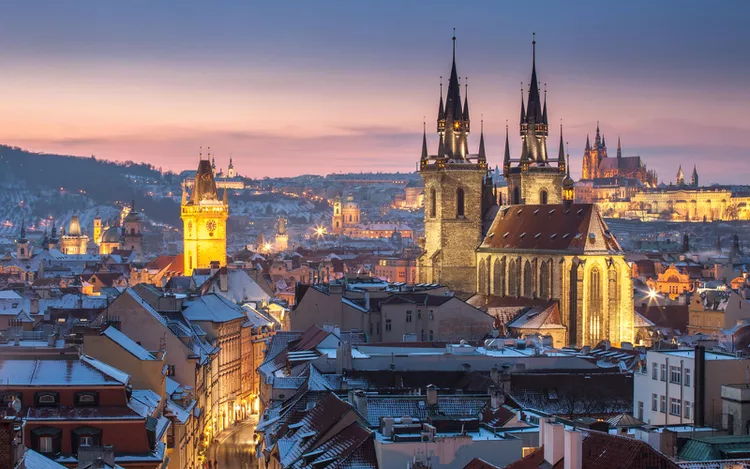Summary of Prague’s Enchanting History
- Lawbreakers have been tossed out of Prague Castle’s windows.
- The Crown Jewels are seriously secure.
- The Butcher of Prague held court at Prague Castle.
- There’s an ancient relic for dancers.
- The Prague Castle is in the Guinness Book of World Records.
- There’s a tropical garden.
- Kafka spent time writing at Prague Castle.
Discover the Hidden Secrets of Prague Castle
Prague is one of those places that seems like it was plucked straight from a fairytale. Head to Prague Castle, specifically, and you’ll be tricked into thinking you’re on the set of a Disney movie. This complex of castles has been around since the 9th century and remains in use today as both a hotspot for tourist photos and the official home of the Czech Republic’s president.
Prague Castle has its share of secrets, as any age-old landmark does. Read about seven fascinating facts about the Czech landmark, ahead.
Lawbreakers have been tossed out of Prague Castle’s windows.

The word “defenestration,” which means throwing someone out of a window, was actually created because of an incident that occurred at Prague Castle in 1618. A year prior, Roman Catholic officials had shut down a pair of new Protestant chapels. Angry Protestant-rights defenders called for a trial in the council room at the Castle and won.
What happened next went down in history: Two Catholic regents and their secretary — all found guilty of violating the right to religious freedom — were shoved out the window. Luckily, a pile of horse manure broke their fall and they emerged uninjured.
The Crown Jewels are seriously secure.

Stowed away in a chamber inside St. Vitus Cathedral, the Bohemian Crown Jewels include the St. Wenceslas crown, royal scepter, and coronation cloak. The Republic isn’t taking any chances with their safekeeping, either, considering both the chamber door and iron safe inside have seven locks. The keys are held by seven people, including the president, prime minister, and Prague archbishop.
Only the president can make the call of how Prague’s Bohemian Crown Jewels are displayed publicly. They are typically put on exhibit every five years or so. When this happens, all seven key holders must be present for the unlocking process.
The Butcher of Prague held court at the Prague Castle.

A crucial Holocaust organizer, Reinhard Heydrich, held court at Prague Castle starting in 1941. Assigned by Hitler to rule the Czech people of Bohemia-Moravia, he quickly set out on a campaign of disappearances and executions. Terrified Czechs nicknamed him The Butcher of Prague. But a group of exiled Czech government officials decided to take action, hatching a plan called Operation Anthropoid to assassinate Heydrich.
In May 1942, several months after parachuting into the country and heading for Prague, two Czech soldiers hopped on bicycles and rode toward Prague Castle. When they spotted The Butcher in his Mercedez convertible, they made their move, shooting and tossing grenades his way. Heydrich died from his wounds a week later, and the 2016 film “Anthropoid” is based on the incredible story.
There’s an ancient relic for dancers.

St. Vitus Cathedral holds the most extensive church treasury in the Czech Republic and among the largest collections in Europe. Some items can be traced back to the early Middle Ages, but one relic, in particular, stands out. That’s the arm of Saint Vitus, a Sicilian who died a martyr when the co-ruling Roman Emperors Diocletian and Maximian cracked down on Christians in 303.
Years later, in the Late Middle Ages, people in countries like Germany and Latvia celebrated the feast of Vitus by dancing at his statue. Today, he’s known as the patron saint of dancers and entertainers, as well as epileptics. He’s also believed to protect against lightning strikes.
The Prague Castle is in the Guinness Book of World Records.

The Prague Castle complex is enormous, with an area totaling approximately 753,473 square feet. That makes it the largest ancient castle in the world, according to the Guinness Book of World Records. The complex extends down to the Lesser Quarter, or Mala Strana, where several chateaux and palaces are found. Wallenstein Palace, for one, is home to the Czech Senate and includes 26 houses and six gardens.
There’s a tropical garden.

Back in the 16th century, the Holy Roman Emperor Rudolf II had a garden of tropical plants, including citrus trees, at Prague Castle. The tradition continues today at the Orangery, a tubular-shaped, glass-enclosed greenhouse built in 1999 in the Royal Gardens.
Dreamed up by Olga Havlová — then-president Václav Havel’s first wife — the three-part structure includes space for budding, growing, and maintaining different tropical plants and Mediterranean fruits. It’s open to visitors in the summer.
Kafka spent time writing at Prague Castle.

Golden Lane, a small street just behind Prague Castle, has charming rows of little houses. These days, tourists mill around and shop for souvenirs on some of the lower floors, but in the last years of the 16th century, alchemists under Emperor Rudolf II lived here and reportedly tried to turn metal into gold. Much later, from 1916 to 1917, the novelist Franz Kafka lived in house No. 22 with his sister. It was a good move, it seems, as Kafka wrote short stories for “A Country Doctor” and was inspired to write his book “The Castle” during his Golden Lane stay.





